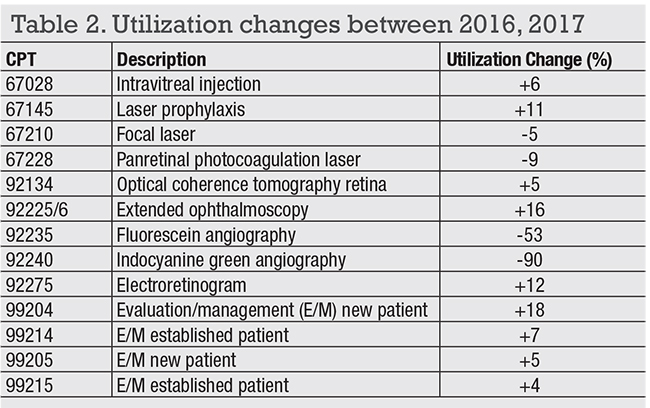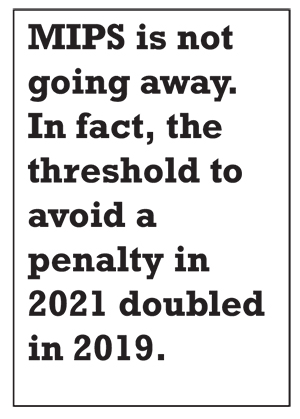The new year has come and with it several coding changes and updates. Some of the changes are minor while others are more significant. Here, we’ll touch on changes in Current Procedural Terminology (CPT) codes, reimbursement rates, a few administrative matters and some miscellaneous items like utilization for various services, along with an important update to the Merit-based Incentive Payment System (MIPS).
 |
Physician Fee Schedule changes
The Centers for Medicare and Medicaid Services published the 2019 Medicare Physician Fee schedule in November.1 The conversion factor remained relatively flat, increasing slightly from 35.9996 to 36.0391. Conversely, Table 1 lists several noteworthy changes in reimbursement from 2018 to 2019. The largest changes in reimbursement occurred in the test category, which includes ultrasounds as well as imaging.
 |
The 2019 rates for surgical procedures, including intravitreal injections, vitrectomy procedures and lasers, remained within 1 percent of 2018 rates. The exception is a 19 percent reduction to CPT 67515, “Injection of medication or other substance into Tenon’s capsule.”2 Office visit codes commonly used by retina specialists, including 99205, 99215, 99204, 99214, 92004 and 92014, also remained within 1 percent of the 2018 rates.
Code changes
Electroretinograpy testing has undergone numerous CPT changes. The longstanding ERG code, 92275, “Electroretinography with interpretation and report,” was deleted in 2019. In its place, CPT added three new codes:
• 92273 —Electroretinography (ERG), with interpretation and report; full field (i.e., ffERG, flash ERG, Ganzfeld ERG).
• 92274—ERG with interpretation and report; multifocal (mfERG).
• 0509T—ERG with interpretation and report, pattern (PERG).
CPT added new instructions to assist with code selection for the different ERGs. The guidance requires that the ERG testing method must match the techniques listed in each code. If not, the unlisted code is to be used. It states:
ERG is used to evaluate function of the retina and optic nerve of the eye, including photoreceptors and ganglion cells. A number of techniques that target different areas of the eye, including full field (flash and flicker, 92273) for a global response of photoreceptors in multiple separate locations in the retina, including the macula, and pattern (0509T) for retinal ganglion cells are used. Multiple additional terms and techniques are used to describe various types of ERG. If the technique used is not specifically named in the code descriptions for 92273, 92274, 0509T, use the unlisted procedure code 92499.2
The rates for the three new codes, 92273, 92274 and 0509T, are $136, $92 and $81, respectively (0509T is a Category III code, which means reimbursement and coverage is at the payer’s discretion). These rates are less than the 2018 rate of $153 for 92275.
In October 2018, the Food and Drug Administration approved the new fluocinolone acetonide implant (YUTIQ, EyePoint Pharmaceuticals), for treatment of chronic non-infectious uveitis affecting the posterior segment.3 Use supply code J7313 “Injection of fluocinolone acetonide, intravitreal implant, 0.01 mg” with 18 units when submitting a claim.
 |
Administrative changes
Several other areas changed as well. First, the annual deductible for Medicare Part B increased $2 to $185.4 Second, CMS is reversing the Change Request (CR) 10318 to the National Coverage Determination (NCD) 80.11 Vitrectomy, implemented in October 2017,5 that caused erroneous vitrectomy denials. CR 10859, released September 2018 and revised in November, published that all ICD-10 codes removed in 2017 are reinstated retroactively to before CR 10318 was published.6
The CMS Quality Payment Program (QPP) made several changes in 2019. The most noteworthy is an increase in the performance threshold to avoid the penalty for physicians and/or physician groups participating in MIPS. For 2019, the threshold to avoid a penalty in 2021 increased from 15 points in 2018 to 30 points in 2019.7 The range for payment adjustments in 2021 based on 2019 participation increases to +/- 7 percent.8
Utilization changes
Some noteworthy changes in select services that ophthalmologists provide to Medicare beneficiaries occurred between 2016 and 2017. While Medicare does not report “Retina only” data, retina specialists provide many of the services listed in Table 2, which shows the percentage of change in volume from 2016 to 2017.
 |
It’s important to note that the large decrease in volume for fluorescein (92235) and indocyanine green (92240) angiography resulted from both codes being modified from unilateral to bilateral in 2017. Prior to 2017, the two codes reimbursed for each eye.
Bottom line
For 2019, there are several important changes in reimbursement for selected codes, including ERG testing. Monitor payment for vitrectomy procedures to ensure Medicare and other payers that follow NCD 80.11 process claims accurately. Finally, MIPS is not going away. In fact the threshold to avoid a penalty in 2021 doubled in 2019. RS
REFERENCES
1. Centers for Medicare & Medicaid Services. Physician Fee Schedule. CMS- 1693-F. https://www.cms.gov/Medicare/Medicare-Fee-for-Service-Payment/ PhysicianFeeSched/PFS-Federal-Regulation-Notices-Items/CMS-1693-F. html. Accessed December 4, 2018.
2. CPT Editorial Panel. 2019 Current Procedural Terminology Professional Edition. Chicago, IL: American Medical Association; 2018.
3. Food and Drug Administration. New Drug Approval (NDA). https://www. accessdata.fda.gov/drugsatfda_docs/appletter/2018/210331Orig1s000ltr. pdf. Accessed December 8, 2018.
4. Centers for Medicare & Medicare Services Newsroom. 2019 Medicare Parts A & B Premiums and Deductibles. October 12, 2018. https://www. cms.gov/newsroom/fact-sheets/2019-medicare-parts-b-premiums-and- deductibles. Accessed December 4, 2018.
5. ICD-10 and Other Coding Revision to National Coverage Determinations (NCD). Change Request 10318. https://www.cms.gov/Regulations-and- Guidance/Guidance/Transmittals/2018Downloads/R2005OTN.pdf. Accessed December 8, 2018.
6. ICD-10 Coding Revisions to National Coverage Determinations (NCD). Medlearn Matters MM10859 Revised. https://www.cms.gov/Outreach- and-Education/Medicare-Learning-Network-MLN/MLNMattersArticles/ downloads/MM10859.pdf. Accessed December 8, 2018.
7. Qulaity Payment Program Year 3. Final Rule Overview. https://www.cms. gov/Medicare/Quality-Payment-Program/Resource-Library/Year-3-Final- Rule-overview-fact-sheet.pdf. Accessed December 10, 2018.
8. The Merit Based-Incentive Payment System: MIPS Scoring Methodology Overview. https://www.cms.gov/Medicare/Quality-Initiatives-Patient- Assessment-Instruments/Value-Based-Programs/MACRA-MIPS-and-APMs/ MIPS-Scoring-Methodology-slide-deck.pdf. Accessed December 10, 2018.



